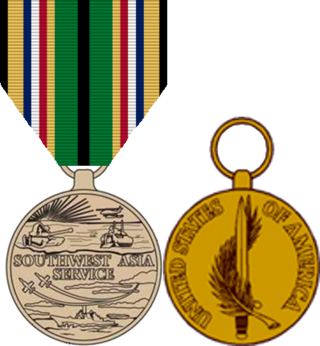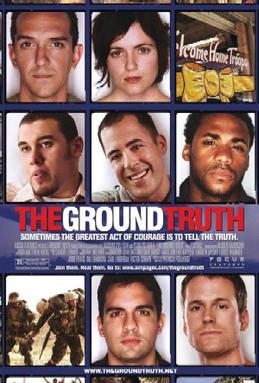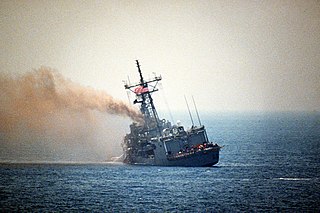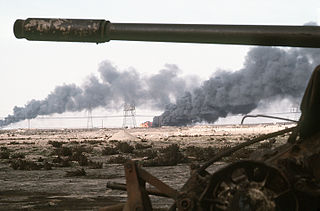
The Kuwaiti oil fires were caused by the Iraqi military setting fire to a reported 605 to 732 oil wells along with an unspecified number of oil filled low-lying areas, such as oil lakes and fire trenches, as part of a scorched earth policy while retreating from Kuwait in 1991 due to the advances of US-led coalition forces in the Gulf War. The fires were started in January and February 1991, and the first oil well fires were extinguished in early April 1991, with the last well capped on November 6, 1991.

The Gulf War was an armed conflict between Iraq and a 42-country coalition led by the United States. The coalition's efforts against Iraq were carried out in two key phases: Operation Desert Shield, which marked the military buildup from August 1990 to January 1991; and Operation Desert Storm, which began with the aerial bombing campaign against Iraq on 17 January 1991 and came to a close with the American-led liberation of Kuwait on 28 February 1991.
This is a list of aviation-related events from 1987.

The Southwest Asia Service Medal is a military award of the United States Armed Forces which was created by order of President George H.W. Bush on March 12, 1991. The award is intended to recognize those military service members who performed duty as part of the Persian Gulf War and for a time thereafter. The medal was designed by Nadine Russell of the Army's Institute of Heraldry. The colors of the ribbon are tan, representing sand, with the black, white, red, blue, and green colors symbolizing the colors of coalition countries' national flags.
The Global War on Terrorism Expeditionary Medal (GWOT-EM) is a United States Armed Forces award created by George W. Bush on 12 March 2003, through Executive Order 13289. The medal recognizes those military service members who have deployed overseas in direct service to the War on Terror from 11 September 2001 to a date to be determined. Prior to 30 April 2005, the medal was awarded for service within Iraq and Afghanistan, but has been replaced with the Iraq Campaign Medal and Afghanistan Campaign Medal and serves primarily as recognition for personnel who have deployed in support of the War on Terror to locations beyond Iraq and Afghanistan. In a similar fashion the Inherent Resolve Campaign Medal is issued for service in the fight against ISIS, with eligibility retroactive to 15 June 2014.

USS Nicholas (FFG-47), an Oliver Hazard Perry-class frigate, was the third ship of the United States Navy to be named for Major Samuel Nicholas, the first commanding officer of the United States Marines. A third-generation guided missile frigate of the Oliver Hazard Perry class, she was laid down as Bath Iron Works hull number 388 on 27 September 1982 and launched 23 April 1983. Sponsor at her commissioning there on 10 March 1984 was the same Mrs. Edward B. Tryon who sponsored DD 449 in 1942.
The Gulf and Kuwait Medal was a campaign medal created in 1990 to recognize members of the Canadian Forces who had directly participated in the Gulf War, either in the hostilities themselves or during the troop build-up prior to the invasion of Iraq. It is, within the Canadian system of honours, the third highest of the war and operational service medals.

The Arab states of the Persian Gulf or the Arab Gulf states refers to a group of Arab states bordering the Persian Gulf. There are seven member states of the Arab League in the region: Bahrain, Kuwait, Iraq, Oman, Qatar, Saudi Arabia, and the United Arab Emirates. Yemen is bound to the six countries of the Gulf Cooperation Council, based on history and culture.
The aftermath of Gulf War saw drastic and profoundly significant political, cultural, and social change across the Middle East and even in areas outside those that were directly involved.

Australia was a member of the international coalition which contributed military forces to the 1991 Gulf War, also known as Operation Desert Storm. More than 1,800 Australian Defence Force (ADF) personnel were deployed to the Persian Gulf from August 1990 to September 1991, while contingents from the Royal Australian Navy circulated through the region in support of the sanctions against Iraq until November 2001. In August 1990, two frigates HMAS Adelaide and HMAS Darwin and the replenishment ship HMAS Success left for the Persian Gulf. HMAS Success had no air defences, so the Army 16th Air Defence Regiment was embarked. On 3 December 1990, HMAS Brisbane and HMAS Sydney (IV) relieved HMAS Adelaide and HMAS Darwin. On 26 January 1991, HMAS Westralia replaced HMAS Success. A Navy clearance diving team was also deployed for explosive ordnance disposal and demolition tasks. Australian ships were in danger of sea mines and possible air attacks. In a number of recorded incidents, HMAS Brisbane encountered free floating mines, on one occasion narrowly avoiding a collision. Both HMA Ships Brisbane and Sydney encountered significant air threat warnings from Iran and Iraq throughout the initial period of the commencement of the Desert Storm Campaign. The detection of land based Silkworm anti-ship missiles from Iran throughout the campaign also added to the challenges for both crews as well as the multi-national Naval Forces.

Operation Friction was a Canadian military operation that saw the contribution of 4,500 Canadian Forces personnel to the 1991 Gulf War. The larger US components were Operation Desert Shield and Operation Desert Storm.
The Persian Gulf Command was a United States Army service command established in December 1943 to facilitate the supply of US lend-lease war material to the Soviet Union, through the "Persian Corridor".

The Ground Truth is a 2006 documentary film about veterans of the Iraq War. It was directed and produced by Patricia Foulkrod.
Dual containment was an official US foreign policy aimed at containing Ba'athist Iraq and Revolutionary Iran. The term was first officially used in May 1993 by Martin Indyk at the Washington Institute for Near East Policy and officially announced on February 24, 1994 at a symposium of the Middle East Policy Council by Indyk, who was the senior director for Middle East Affairs of the National Security Council (NSC).

Gulf War syndrome (GWS) also known as Gulf War Illness or Chronic Multi-symptom Illness, is a chronic and multi-symptomatic disorder affecting military veterans of both sides of the Gulf War (1990–1991). A wide range of acute and chronic symptoms have been linked to it, including fatigue, muscle pain, cognitive problems, insomnia, rashes and diarrhea. Approximately 250,000 of the 697,000 U.S. veterans who served in the Gulf War have enduring chronic multi-symptom illness, a condition with serious consequences. From 1995 to 2005, the health of combat veterans worsened in comparison with nondeployed veterans, with the onset of more new chronic diseases, functional impairment, repeated clinic visits and hospitalizations, myalgic encephalomyelitis/chronic fatigue syndrome-like illness, post-traumatic stress disorder, and greater persistence of adverse health incidents.

The USS Stark incident occurred during the Iran–Iraq War on 17 May 1987 in the Persian Gulf, when an Iraqi jet aircraft fired two Exocet missiles at the U.S. frigate USS Stark. A total of 37 United States Navy personnel were killed or later died as a result of the attack, and 21 were injured.

The First Gulf War (1990) and the 2003 Iraq War, also known as the Second Gulf War, brought about significant environmental degradation with several facets still negatively impacting the area today. As a frame of reference, the Persian Gulf countries consist of the following states: the UAE, Bahrain, Oman, Qatar, Saudi Arabia, Iraq and Kuwait, with the latter two facing the most environmental damage following the two wars due to their central position in the conflict.

Ali Fadavi is an Iranian military officer who currently holds office as the deputy commander-in-chief of the Islamic Revolutionary Guard Corps.
The timeline of the Gulf War details the dates of the major events of the 1990–1991 war. It began with the Iraqi invasion of Kuwait on 2 August 1990 and ended with the Liberation of Kuwait by Coalition forces. Iraq subsequently agreed to the United Nations' demands on 28 February 1991. The ground war officially concluded with the signing of the armistice on 11 April 1991. However, the official end to Operation Desert Storm did not occur until sometime between 1996 - 1998. Major events in the aftermath include anti-Saddam Hussein uprisings in Iraq, massacres against the Kurds by the regime, Iraq formally recognizing the sovereignty of Kuwait in 1994, and eventually ending its cooperation with the United Nations Special Commission in 1998.













